Measuring Dry Ingredients | Weight Versus Volume
Measuring Solid Fats | Measuring Liquid Ingredients
| When making bread, it is critical to use precise measurements. Unlike general cooking in which precise measurements are often not as critical, inaccurate measurements in bread making (and most baked items) affect the chemical processes that occur during the preparation and baking. Slight variations in the ingredient quantities can adversely affect the results. Described below are some useful measuring techniques. |
Measuring Dry Ingredients for Bread Making
| When using measuring cups to measure larger quantities of dry ingredients such as flour, granulated sugar, and powdered sugar, the ingredients should be spooned into the measuring cup until heaping over the top of the cup. It may be beneficial to stir the dry ingredients to aerate the ingredient and remove any lumps that have developed. Do not shake, tap, or pack the ingredient into the cup. Using the back edge of a knife or another straight edged object, level the ingredient by running the straight edge along the rim of the cup to remove the excess. The same technique can be used for ingredients that are bulkier and less finely ground, such as meal, cracked grains, or finely chopped nuts. |
 |
| Brown sugar can be measured with this method, but it must be packed firmly into the measuring cup to eliminate air pockets before it is leveled with a straight edge. After the brown sugar is removed from the measuring cup, it should retain the shape of the cup if it was packed properly. |
| When using spoons to measure dry ingredients such as baking powder, baking soda, or salt, pour or scoop the ingredients into the spoon. Use the back edge of a knife or another straight edged object to level the ingredient by running the straight edge along the rim of the spoon to remove the excess. |
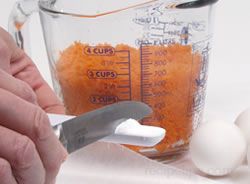 |
Weight Versus Volume
| A kitchen scale can be used to measure flour by weight for the most accurate quantity. Occasionally, the quantity of flour that is actually contained in a measuring device may be inaccurate due to several factors, such as the manner in which the flour is added to the measuring device, the degree in which the flour is compacted, and the humidity level. Using a scale to weigh the ingredient eliminates the inaccuracy and provides a more precise measurement. Because flour is generally the major ingredient in most breads, it is important to be as accurate as possible with measuring flour to achieve the best results. It is also worth noting that different types of flour do not weigh the same. |
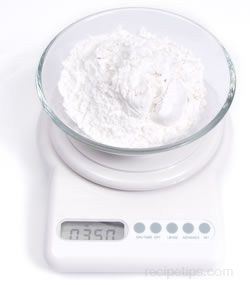 |
|
Weight of Flour - Per 1 Cup
(approximate weights)
|
|
All Purpose Flour
Whole Wheat Flour
Bread Flour
Rye Flour |
4 3/8 oz or 125 g
4 1/4 oz or 120 g
4 1/2 oz or 127 g
3 5/8 oz or 102 g
|
Measuring Solid Fats for Bread Making
| Butter and margarine in stick form have measurements already marked on the wrappers, making it very convenient to measure the required amount. Simply cut off the quantity required according to the indications on the wrapper, which is usually marked in tablespoons. One stick of butter or margarine equals 8 tablespoons or ½ cup. One-half stick equals 4 tablespoons or ¼ cup and 1 tablespoon (1/8 of a stick) equals 3 teaspoons. |
 |
| Shortening (and other solid fats) should be spooned into a measuring device and packed firmly to eliminate any air pockets. After it is firmly packed it can be leveled with a straight edge, such as the back edge of a knife. |
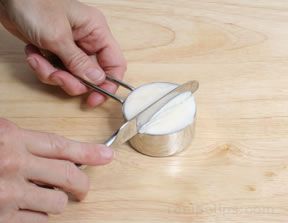 |
Measuring Liquid Ingredients for Bread Making
|
It is best to use transparent plastic or glass measuring cups with pour spouts to measure large quantities of liquid, such as water or milk, and for sticky ingredients, such as syrup, honey, or molasses. Measuring spoons are used to measure small quantities of these ingredients.
Pour the liquid ingredient into the measuring cup until it is at the desired measure. Make sure the measuring cup is sitting on a flat, level surface and view the measurement at eye level. Do not hold the cup up at eye level because the cup may not be level when viewing, resulting in an inaccurate reading. |
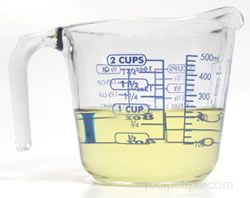 |
| When using measuring spoons, hold the spoon flat and pour the ingredient into the spoon until it reaches the top rim of the spoon. |
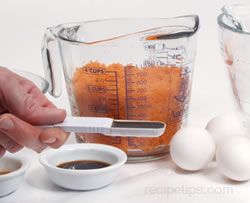 |
|
When measuring sticky ingredients, such as honey, molasses, and syrup, lightly coat the inside of the measuring cup with vegetable oil or cooking spray, which will allow the sticky ingredients to slide out easily. If the bread recipe calls for oil, you can measure the oil before measuring the sticky ingredients and then use the same cup, without washing it, to measure the sticky ingredient.
Removal of sticky ingredients can also be assisted by using metal measuring cups or spoons and filling them with boiling water for a few minutes and then pouring the ingredients in them. The heated metal will allow the sticky ingredients to pour out easily. |
| Note: Never measure ingredients over the mixing bowl containing the other ingredients. You may accidentally over-fill or tip the measuring device resulting in the excess ingredients falling into the mixture, which could ruin the dough or batter (depending on the ingredient and the quantity spilled). It is best to measure ingredients over a sink, another bowl, or a sheet of wax paper to catch excess spillage. Excess ingredients caught on wax paper can be returned to the appropriate container. | |







